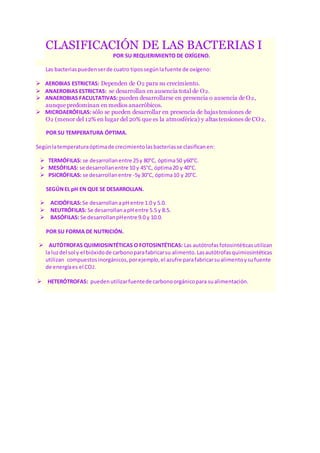Bacterias y su clasificacion
•Descargar como DOCX, PDF•
0 recomendaciones•188 vistas
Denunciar
Compartir
Denunciar
Compartir

Recomendados
Recomendados
More than Just Lines on a Map: Best Practices for U.S Bike Routes
This session highlights best practices and lessons learned for U.S. Bike Route System designation, as well as how and why these routes should be integrated into bicycle planning at the local and regional level.
Presenters:
Presenter: Kevin Luecke Toole Design Group
Co-Presenter: Virginia Sullivan Adventure Cycling AssociationMore than Just Lines on a Map: Best Practices for U.S Bike Routes

More than Just Lines on a Map: Best Practices for U.S Bike RoutesProject for Public Spaces & National Center for Biking and Walking
Más contenido relacionado
Destacado
More than Just Lines on a Map: Best Practices for U.S Bike Routes
This session highlights best practices and lessons learned for U.S. Bike Route System designation, as well as how and why these routes should be integrated into bicycle planning at the local and regional level.
Presenters:
Presenter: Kevin Luecke Toole Design Group
Co-Presenter: Virginia Sullivan Adventure Cycling AssociationMore than Just Lines on a Map: Best Practices for U.S Bike Routes

More than Just Lines on a Map: Best Practices for U.S Bike RoutesProject for Public Spaces & National Center for Biking and Walking
Destacado (20)
Content Methodology: A Best Practices Report (Webinar)

Content Methodology: A Best Practices Report (Webinar)
How to Prepare For a Successful Job Search for 2024

How to Prepare For a Successful Job Search for 2024
Social Media Marketing Trends 2024 // The Global Indie Insights

Social Media Marketing Trends 2024 // The Global Indie Insights
Trends In Paid Search: Navigating The Digital Landscape In 2024

Trends In Paid Search: Navigating The Digital Landscape In 2024
5 Public speaking tips from TED - Visualized summary

5 Public speaking tips from TED - Visualized summary
Google's Just Not That Into You: Understanding Core Updates & Search Intent

Google's Just Not That Into You: Understanding Core Updates & Search Intent
The six step guide to practical project management

The six step guide to practical project management
Beginners Guide to TikTok for Search - Rachel Pearson - We are Tilt __ Bright...

Beginners Guide to TikTok for Search - Rachel Pearson - We are Tilt __ Bright...
Unlocking the Power of ChatGPT and AI in Testing - A Real-World Look, present...

Unlocking the Power of ChatGPT and AI in Testing - A Real-World Look, present...
More than Just Lines on a Map: Best Practices for U.S Bike Routes

More than Just Lines on a Map: Best Practices for U.S Bike Routes
Ride the Storm: Navigating Through Unstable Periods / Katerina Rudko (Belka G...

Ride the Storm: Navigating Through Unstable Periods / Katerina Rudko (Belka G...
Bacterias y su clasificacion
- 1. CLASIFICACIÓN DE LAS BACTERIAS I POR SU REQUERIMIENTO DE OXÍGENO. Las bacteriaspuedenserde cuatro tipossegúnlafuente de oxígeno: AEROBIAS ESTRICTAS: Dependen de O2 para su crecimiento. ANAEROBIAS ESTRICTAS: se desarrollan en ausencia total de O2. ANAEROBIAS FACULTATIVAS: pueden desarrollarse en presencia o ausencia de O2, aunque predominan en medios anaeróbicos. MICROAERÓFILAS: sólo se pueden desarrollar en presencia de bajas tensiones de O2 (menor del 12% en lugar del 20% que es la atmosférica) y altas tensiones de CO2. POR SU TEMPERATURA ÓPTIMA. Segúnlatemperaturaóptimade crecimientolasbacteriasse clasificanen: TERMÓFILAS: se desarrollanentre 25y 80°C, óptima50 y60°C. MESÓFILAS: se desarrollanentre 10 y 45°C, óptima20 y 40°C. PSICRÓFILAS: se desarrollanentre -5y30°C, óptima10 y 20°C. SEGÚNEL pH EN QUE SE DESARROLLAN. ACIDÓFILAS:Se desarrollanapH entre 1.0 y 5.0. NEUTRÓFILAS: Se desarrollanapH entre 5.5 y 8.5. BASÓFILAS: Se desarrollanpHentre 9.0 y 10.0. POR SU FORMA DE NUTRICIÓN. AUTÓTROFAS QUIMIOSINTÉTICAS O FOTOSINTÉTICAS: Las autótrofasfotosintéticasutilizan la luzdel sol y el bióxidode carbonoparafabricarsu alimento.Lasautótrofasquimiosintéticas utilizan compuestosinorgánicos,porejemplo,el azufre parafabricarsualimentoysufuente de energíaes el CO2. HETERÓTROFAS: puedenutilizarfuentede carbonoorgánicopara sualimentación.
